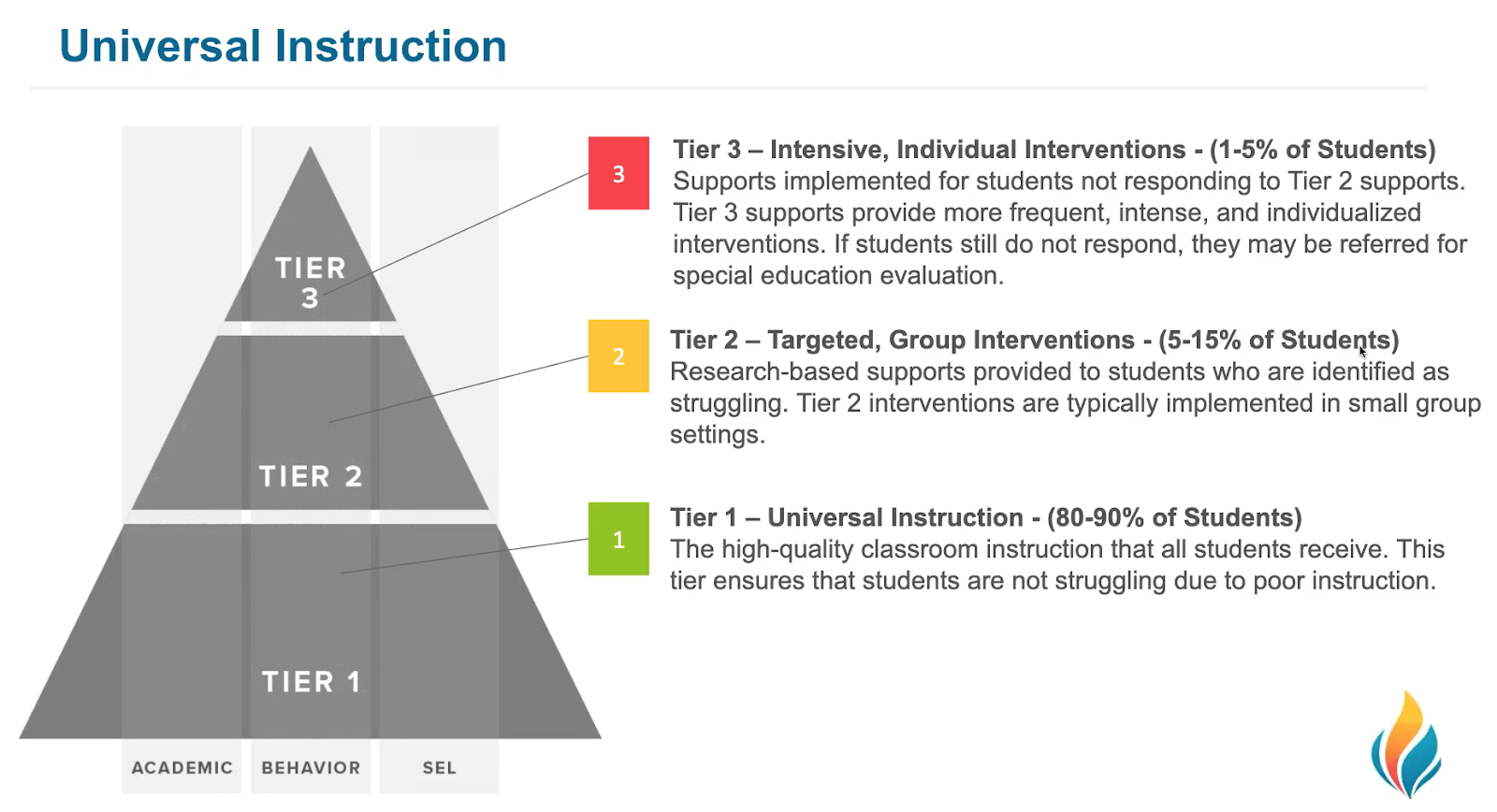This spring, learning has shifted primarily in three ways.
Some schools have completely closed and teachers are no longer working with students, while others have adapted to a model in which attendance is optional and work is ungraded. And a few schools are still operating on a familiar schedule where attendance is expected and work is graded.
In any case, formative assessment is as important as ever. When teachers can’t be in the same room as the students, having access to key data to determine student needs is really essential.
But how does this happen in a virtual learning environment?
You may discover that screening data is really valuable at identifying students whose learning has plateaued so that you can act now to prevent any further slide.
In this post, we’ll offer some thoughts on how you can use spring screening data to identify students who may need additional support, and then discuss strategies to engage students whose learning appears to have plateaued.
Identifying Students in Need of Additional Support
Under normal circumstances, the questions we typically want to address with spring screening spring is how much should our students benefit from instruction this year? Or who has met the benchmark?
Under the current circumstances, the questions may need to shift to questions such as the following:
- How is the COVID crisis impacting student learning?
- Which students made little or no growth since winter?
- Are we preventing the COVID slide?
The big question on the minds of most educators it's whether or how much learning is being impacted by the COVID crisis. The question can be posed at many levels: individual students, virtual classrooms, schools, and districts. A proper group growth report can be used to address the question at all levels.
Growth is reported as the average weekly rate of improvement. It shows how much a student's score changed from one screening period to the next. It's important to note that growth does not determine a student's level of risk. Risk is about a student's level of performance in a specific screening period, while growth is about the rate of progress across screening periods. In other words, a student may have an aggressive growth rate from fall to winter, but still be at some risk level in the winter. It’s also possible for a student to be at low risk and have flat growth across seasons.
A reliable group growth report — like the one that exists within the FastBridge assessment system — should show the percentage of students in each of the four categories: flat, modest, typical and aggressive. A typical pattern is one that matches the national norms featuring 15% of the students in the flat category, 25% of the students in the modest category, and the remaining 60% divided across the typical and aggressive categories. As a rule of thumb, if more than 50% of the student growth rates fall below the typical category in the two lower categories, it is reasonable to assume that growth has been negatively impacted.
To determine whether learning has been affected, review the growth percentile for each student.
The best method is to compare the percentages from the fall-to-winter period, then re-run the report for fall-to-spring. If the percentage of students below the typical level increases, which means the percent in the lower two categories increases by 10% or more, then learning has likely been impacted. This strategy can be used to evaluate the impact of any possible slide.
Four Ways to Foster Student Engagement
So, once you've collected your spring data and determined which students are at-risk, what's next? We've identified four specific ways that teachers can help facilitate student engagement through remote learning to help increase student learning outcomes.
1) Relationship building
One of the first things to do for all students, but particularly students who have not been engaged with online learning, is to reach out to them and take time to connect. There's a long body of research indicating that if just one adult shows a child that he or she really cares, it can have a very significant effect on that student's long term resilience and success.
During this time, when at home environments are likely somewhat stressful, because parents are being pulled in so many directions. Children really need teachers who reach out and let them know they care in ways that go well beyond that whether or not the student is completing the assigned activities.
This can include weekly emails, just supporting them in various activities, and or commenting on how well they've done in the past on various school assignments. Also, facilitate ways for students to connect with each other. Just as we're all desperate for more social interaction, students are as well, and we can’t assume that all of them are facilitating student-to-student interactions on their own.
Just so they know that there is a caring adult who's connected to them and wants to help them be successful.
2) Motivation
Generally, what motivates adults can often motivate children as well, such as social acknowledgement and praise. Keep students engaged by acknowledging their hard work or giving them praise for participating in the session. It’s easy to overlook, but in these circumstances with many shifting variables, just having a student show up and be present means something.
Also, don’t forget that all the work you’ve invested in learning about your students can help you personalize your motivation tactics. What activities do your students enjoy? What teams, bands, or celebrities do they follow? Including those mentions in your discourse can make a big difference in fostering student engagement.
One last thing to consider is setting up learning activities that include surprises and mystery items, or what some refer to as “easter eggs.” You could ask your students to be on the lookout for the mystery item in the session or lesson. Introducing this kind of novelty within the learning sessions can help keep them tuned in and engaged while providing a bit of humor and good fun.
3) Access
Engaging students also requires the access component. First, there's the basic issue of whether students actually have the devices and internet access to be in the online session. Many schools have invested time and effort to ensure students have some kind of access, but there could still be lingering challenges relative to logistics. Do students have to share devices with siblings? Do they have other at-home responsibilities that might intrude on their learning? These variables will inform your understanding of when students are more likely to be available, as well as the kind of activities you're going to assign to students.
The issue of access also involves the actual learning content. Are the students being required to perform activities that are too difficult or unreasonable? When planning an activity or instruction, consider the “Goldilocks” principle: don’t make it too hard or too easy, but just right. Since you're providing online learning activities, it makes sense to reduce the difficulty level as students are doing more work independently. Finding the sweet spot or the right level of instruction will keep your students motivated in their learning journey.
4) Activities
There are four points to remember when it comes to optimizing learning with activities—frequency, duration, pacing, and response. Let’s explore each one in greater depth.
Frequency
Consider how many days a week your lessons will happen. Granted, the schedule won’t be the same as when learning was on campus, but there still needs to be a regular schedule. Think about the content, student availability, and school expectations. Note that in this case, less might mean more. You might have fewer sessions, but they might be better in quality instruction and student participation. Students will appreciate and benefit from a regular schedule of learning activities.
Duration
Longer is not always better, especially in this current environment. Lessons that are brief and frequent are great aspects to foster engagement. This doesn’t just entail the number of sessions during a week, but also how many times during a given lesson you might do a certain activity. Mix it up and feature diverse and shorter activities during a lesson so that students can stay engaged. This will provide excellent practice time as well as helping students to maintain their skills over time.
Pacing
This has to do with how much material you’re going to cover in what amount of time. This also pulls together the considerations around frequency and duration. The main note is that having spaced practice is going to increase learning more than massed practice. In other words, if you provide more frequent but shorter lessons during which students can be fully engaged, their learning is likely to be much more focused and effective.
Response
Specifically, this means the opportunities for students to respond to instruction. This is a critical piece of engagement because it’s in responding and engaging with teachers and other peers that students are going to make their biggest learning gains. This could include choral response, in which students can participate and respond together to questions (as opposed to one at a time) to ensure everybody is engaged at the same time. You should also provide immediate feedback for students so they can adjust their work and properly learn the material.
Your team can use spring data to identify and support students who are starting to experience loss of learning now. (Don’t wait until the fall!) Take advantage of screening and progress monitoring data to identify and disrupt learning loss. If you’d like to learn more, check out our recorded webinar on this topic.
******
To learn more about the universal screening and progress monitoring tools available within the FastBridge system, visit fastbridge.org or contact us to schedule a demo.







